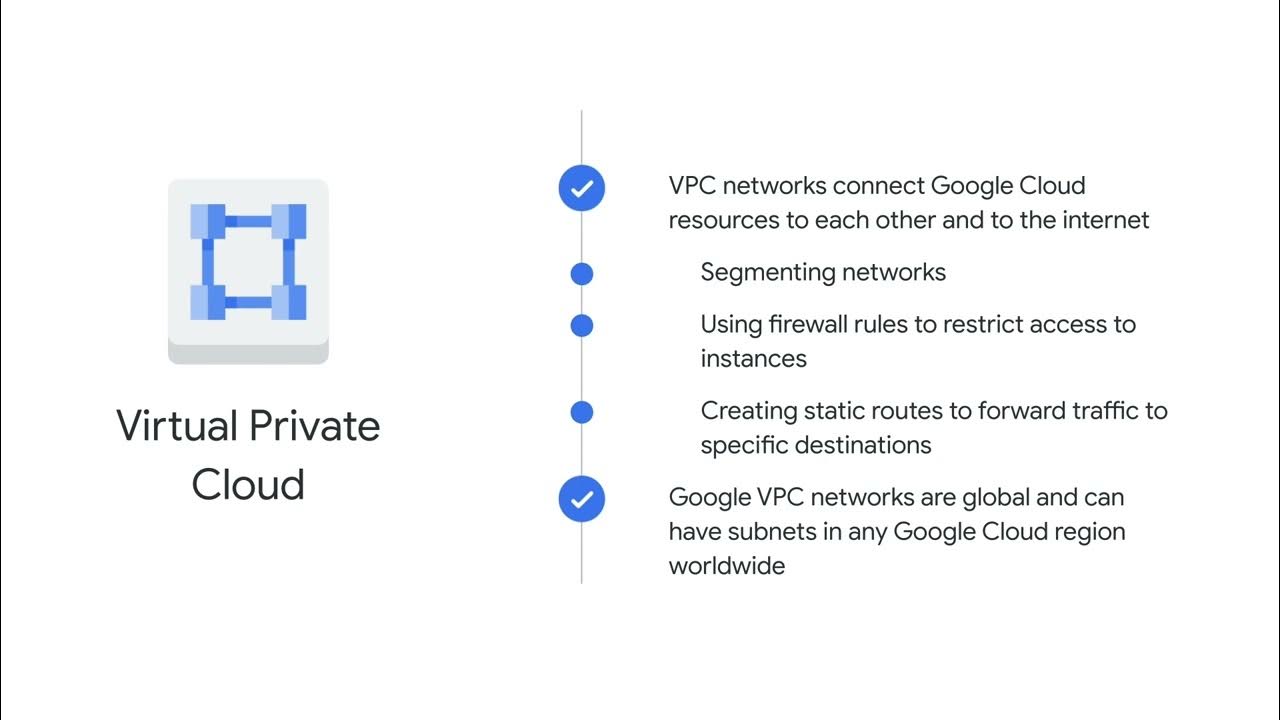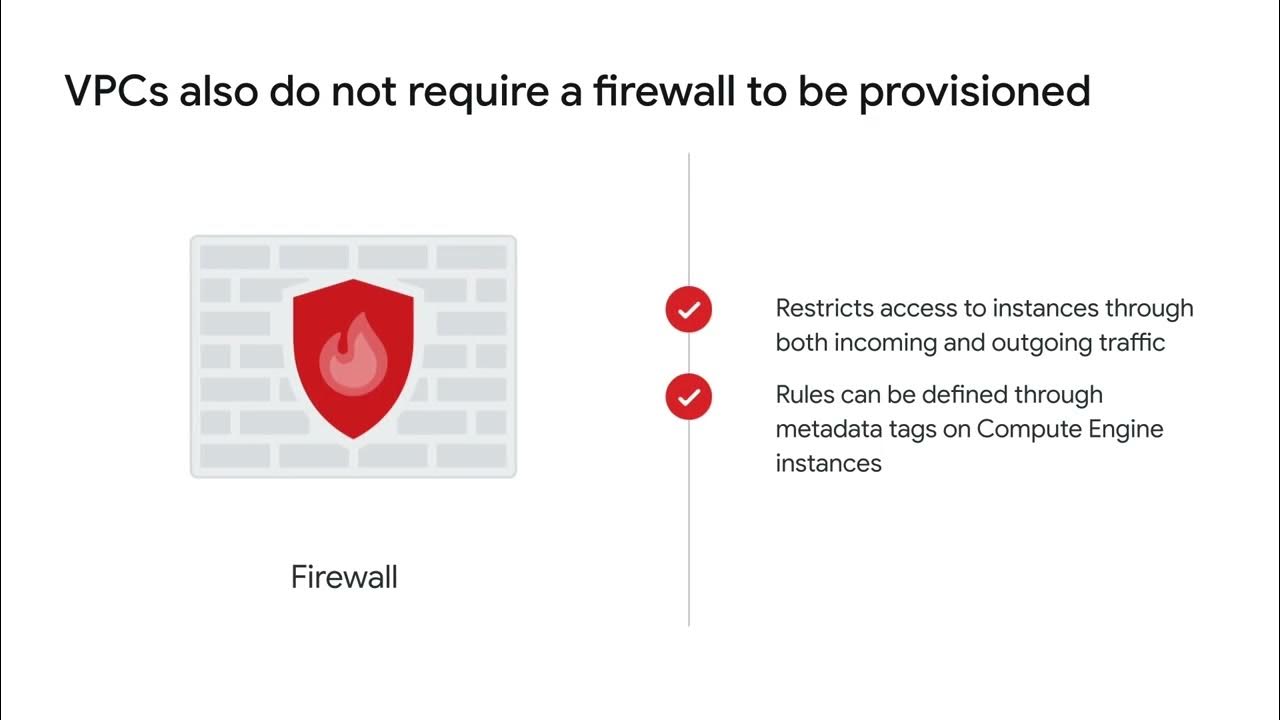The basics of public and internal IP addresses
Summary
TLDRThis video provides an overview of the basics of public and internal IP addresses within a Virtual Private Cloud (VPC). It covers concepts like CIDR ranges, which define available IP addresses for subnets, and the distinction between public and internal IP addresses. Public IPs can be ephemeral or reserved, while internal IPs are allocated via DHCP and are tied to virtual machines. The video explains the importance of IP address configuration for cloud communication, and how internal IPs are used within the VPC for local communication, with periodic renewals through DHCP.
Takeaways
- 😀 A Virtual Private Cloud (VPC) is composed of subnetworks (subnets), each requiring a private IP CIDR address for configuration.
- 😀 CIDR (Classless Inter-Domain Routing) defines the range of internal IP addresses used by virtual machines in a subnet.
- 😀 Internal IP addresses are for communication within the VPC and cannot be routed to the internet.
- 😀 Each octet of an IP address is represented by 8 binary bits, resulting in a 32-bit length for a typical IPv4 address.
- 😀 The CIDR range determines how many IP addresses are available in a subnet, with a /16 range providing 65,536 IP addresses.
- 😀 Adding “1” to the last number in a CIDR range halves the number of available IP addresses.
- 😀 Public (or external) IP addresses can be ephemeral or reserved, and are assigned from a pool associated with the region.
- 😀 Reserved public IP addresses are billed even if not attached to a virtual machine.
- 😀 Virtual machines do not recognize their public IP address and only display their internal IP address in their network configuration.
- 😀 Private (or internal) IP addresses are allocated by a Dynamic Host Configuration Protocol (DHCP) service and have a 24-hour lease renewal.
- 😀 The virtual machine's hostname is associated with its internal IP address through a network-scoped DNS service.
Q & A
What is a Virtual Private Cloud (VPC)?
-A Virtual Private Cloud (VPC) is a private network in the cloud that is logically isolated from other virtual networks. It allows users to launch resources such as virtual machines in a virtualized environment.
What is a CIDR range and why is it important in a VPC?
-CIDR (Classless Inter-domain Routing) is a method for specifying IP address ranges. It is important in a VPC because the CIDR range defines the set of IP addresses that will be used within a subnet of the VPC.
How many bits are in an IPv4 address, and how are they represented?
-An IPv4 address is 32 bits long. Each octet (or part) of the address is represented by 8 binary bits, making up the full 32-bit address.
What does the number at the end of a CIDR range represent?
-The number at the end of the CIDR range indicates how many bits are fixed (or static) in the address. It helps define how many IP addresses are available within that range.
How many IP addresses are available with a /16 CIDR range?
-A /16 CIDR range provides 65,536 available IP addresses.
What happens when you increment the last number in a CIDR range?
-Each time you add '1' to the last number in a CIDR range, the number of available IP addresses is halved.
What is the difference between a public IP address and an internal IP address?
-Public IP addresses are used for communication over the internet, while internal IP addresses are used for communication within the VPC and cannot be routed to the internet.
Can public IP addresses be ephemeral or reserved?
-Yes, public IP addresses can either be ephemeral (temporary) or reserved (persistent). Reserved IP addresses incur costs even if not attached to a virtual machine.
How are internal IP addresses assigned to virtual machines in a VPC?
-Internal IP addresses are assigned to virtual machines by a Dynamic Host Configuration Protocol (DHCP) service, and the lease for these IPs is renewed every 24 hours.
What is the role of the hostname in a virtual machine's network configuration?
-The hostname is the name of the virtual machine and is associated with the internal IP address through a network-scoped DNS service, enabling easier identification within the network.
Outlines

This section is available to paid users only. Please upgrade to access this part.
Upgrade NowMindmap

This section is available to paid users only. Please upgrade to access this part.
Upgrade NowKeywords

This section is available to paid users only. Please upgrade to access this part.
Upgrade NowHighlights

This section is available to paid users only. Please upgrade to access this part.
Upgrade NowTranscripts

This section is available to paid users only. Please upgrade to access this part.
Upgrade NowBrowse More Related Video

Virtual Private Clouds (VPCs)

How to Create an AWS VPC with Public and Private Subnets

Day 59/100 || Create Subnets in AWS VPC Part -2 || 100 Days Cloud Challenge || AWS in English ||

AWS VPC Tutorial | Membuat VPC, Subnet, Route Table | AWS VPC | Central Data Technology

What is a Virtual Private Cloud?

Routes and firewall rules in the cloud
5.0 / 5 (0 votes)